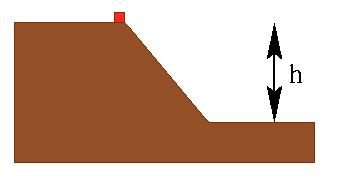Discussion of the Question 07/99
MISSING ENERGYThe question was:
 A body starts sliding (from rest) without friction down a
hill of height h. In the beginning the body has potential
energy and no kinetic energy; at the end the body has only kinetic
energy.
It follows from energy conservation,
mgh=½mv2, that the velocity of the body
at the bottom of the hill will be v=(2gh)1/2.
A body starts sliding (from rest) without friction down a
hill of height h. In the beginning the body has potential
energy and no kinetic energy; at the end the body has only kinetic
energy.
It follows from energy conservation,
mgh=½mv2, that the velocity of the body
at the bottom of the hill will be v=(2gh)1/2.
Now consider the same process from a reference frame moving with velocity v (to the right) relative to the ground. In this reference frame, the body in the beginning has potential energy mgh and kinetic energy (1/2)mv2, while at the end of the process both energies vanish. Where did the energy disappear? Give a detailed account of missing energy!
(7/99) Y. Kantor: Probably, it is our fault, that many people misunderstood the question. Many people sent in solutions which are correct but are NOT what we wanted to hear. Roughly speaking, many solutions were as follows:
Consider the system of Earth and the body in the moving reference frame. In this system, we can use the momentum conservations to determine the velocity of Earth, and from there we can verify that the energy of the system Earth+body is conserved.
We received several solutions of this kind. Some of them used the momentum conservation directly, while others did it less directly, i.e. used the dynamics laws in a form which would lead to momentum conservation. Solutions of this kind were received from G. Fedel (e-mail giulio.fedel@trieste.infn.it), A. Esztermann (e-mail ansgar@thphy.uni-duesseldorf.de), Y. Kats (e-mail yevgenyk@inter.net.il), and D. Augier (e-mail augier@irsamc2.ups-tlse.fr).
There is something strange in solutions of this kind: momentum conservation is used to derive the law of energy conservation. Clearly, this is not possible. Nevertheless, people succeeded doing it because they assumed that they know that the body will be at rest (relative to the moving frame of reference) when it reaches the bottom of the hill. However, this assumption is a consequence of energy conservation, and, therefore, cannot be used in a closed consistent derivation.
What we really want, is a solution which uses dynamical laws in the moving frame of reference and proves energy conservation. In particular, we want a detailed account where and when does the energy of the body go. Let's say it explicitly: the energy of the body decreases because it performs work = negative work is performed on the body; when and what amount of work is performed?
 Back to "front page"
Back to "front page"